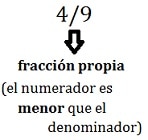The first step we are going to take is to know the etymological origin of the two words that give shape to the term that concerns us now:
-Fraction comes from Latin. Exactly it emanates from “fractio, fractionis”, which can be translated as “piece” or “portion”. It in turn derives from the verb “fragere”, which is synonymous with “break” or “part”.
-Proper, for its part, also comes from Latin, in its case it emanates from “proprius”. This word, in turn, comes from the expression “pro private”, which can be translated as “in favor of what is private”.
In the field of mathematics , an expression that refers to a division is called a fraction . If we take the fraction 4/9 , to cite one case, this expression refers to the fact that the number 4 is divided into 9 . The 4 , in this fraction, is the numerator (the number to be divided), while the 9 is the denominator (the quantity into which the numerator is divided).
 There are different types of fractions . On this occasion, we are going to focus on proper fractions , which are those that have a numerator less than the denominator , both numbers being positive. A proper fraction, therefore, refers to a quantity that is greater than 0 and less than 1 .
There are different types of fractions . On this occasion, we are going to focus on proper fractions , which are those that have a numerator less than the denominator , both numbers being positive. A proper fraction, therefore, refers to a quantity that is greater than 0 and less than 1 .
Returning to the previous example , we can affirm that 4/9 is a proper fraction, since the numerator ( 4 ) is less than its denominator ( 9 ). In turn, 4 divided by 9 gives a result greater than 0 and less than unity: 0.44 .
It doesn't matter how low or high the numerator and denominator are to determine if a fraction is proper: the key is that they are both positive numbers and that the denominator (the number below the dividing line) is greater than the numerator (the number that is located on the dividing line).
1/8000 is a proper fraction. As you can see, the numerator of the fraction is 1 , while the denominator is 8000 . It is simple to realize that the number 1 is less than the number 8000 . If we carry out the division , we will quickly notice that the result is more than 0 and less than 1 : 0.000125 .
In other cases , the difference between numerator and denominator is not so great, but if the numerator is smaller, the fraction will always be proper: 2/4 , 7/8 , 362/370 , etc.
Whenever we talk about proper fractions, we also mention the so-called improper fractions. In this case we have to state that the latter are those fractions that are identified by the fact that the numerator is equal to or greater than the denominator. Examples of this would be, therefore, fractions such as 5/2, 4/3, 9/7 or 6/3, among others.
In the same way, it should be noted that an improper fraction can also be represented as a mixed number. That is, it can be presented as a natural number plus a proper fraction. To achieve this, what you have to do is divide the numerator by the denominator and the quotient that remains is the natural number in question, while the rest of said operation becomes the numerator of the proper fraction that is needed to give it shape. to the aforementioned mixed number.
